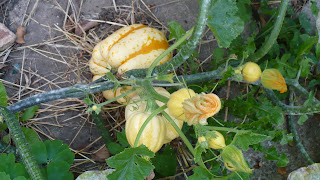
So we are quickly approaching autumn and it's harvest time. This post is long over due and therefore most of the pictures will be a few weeks old, never the less they're still worth sharing.
Lots of food goes to waste in this country these days. Supermarkets, restaurants and and other food stores throw out an astonishing amount of perfectly good edible produce which have either pass their sell by dates, or no longer has that appearance of perfection that the consumers are use to. It amazes me that there are people in the world that still do not have enough to eat, while some of us have way too much. The evidence is in the bins. The picture above is of some vegetables we rescued from a bin behind a health food store, all of which were perfectly safe to eat. This fed eight people and cost nothing.
Now off to May Garden... Update #3 was of what's been going on inside the polytunnel, and so this update is focused on what's been going on everywhere else.
Potatoes have done well, we have had about 12kg so far and there are still four more plants to dig up. We were lucky enough to have had some enormous spuds and they feed us well.
 4.6kg of Potatoes
4.6kg of PotatoesThe artichokes are about to go to flower and so we're about to dig them up. They stand at an amazing 71/2ft high and have stood up to some very strong winds over the past few months.
 Jerusalem Artichokes
Jerusalem ArtichokesApples have been very productive this year, the pruning has done wonders. We've had plenty fruits and we have been enjoying lots and lots of fresh apple juice.
 The Apple Tree...in all its' Glory
The Apple Tree...in all its' Glory Apple Picking
Apple PickingUnfortunately we weren't able to keep up with the supply of apples and a few of them rotted.
Our squashes are soldiering on. We have got a few squash festivals growing on the vine as well as one butter-nut squash. I can't make out what's going on with the butter-nut. We keep getting new flowers that begin to form into fruit...but then they begin to shrivel up and then eventually die and fall off the vine. It's a mystery to us all.
 Squash Festival
Squash Festival
 Butter-nut Squash
Butter-nut SquashWe've had a good crop of runner beans. We were a bit sceptical at first about the runners, the packaging which the seeds came in indicated that the seeds had expired over a year ago. Fortunately no one told that to the seeds.

First in the race - Runner Beans

The courgette plant is a success story. It was on the verge of non existence but slowly fought it's way back to good health and now provides us with some very tasty veg.
 'Green Giant' Courgette
'Green Giant' CourgetteThe tomato plants inside the polytunnel have gotten quite large with a lot of fruits on them but the tomato plants outside have been providing us with some big juicy red tomatoes regularly. They have done very well and the poor plants have been finding it a real struggle to support their own weight.
 Plump sun ripe tomatoes - My Girl Variety
Plump sun ripe tomatoes - My Girl Variety The onset of colder temperatures have some what slowed the growth of some of the plants . The growth of the second batch of herbs; thyme, parsley and basil have come to a crawl. However we are still able to have fresh herbs for cooking on a daily basis.
 Slow growing herbs
Slow growing herbs Green seasoning..... something I remember my mum making back home. This is the best way to get the most out of your herbs. We got a bunch of thyme, a bunch of parsley, a bunch of chive, a bunch of basil and a bit of mint, blended them all together with a bit of sea salt, black pepper, a few cloves of garlic (grown in the garden), two chillies, some water and a generous amount of malt vinegar. This is green seasoning, Caribbean style. It can be kept in the fridge for up to two months and it could be used for seasoning anything, lamb, fish, even vegetable for stewing or roasting. Plus it saves you chopping up lots of individual ingredients.
We have also planted some spring onions and they had a rough start but are now starting to pick up the pace.

When we first decided to plant out the sweet corn we were told not to expect more than two cobs per plant. Well we had, on average, three cobs per plant, and they were surprisingly sweet. They've come to the end of their time now and the black flies have taken over what little is left.
 Sweet Corn
Sweet Corn
Our nasturtium patch seems to be a heaven for black flies, they are absolutely covered in them. It hasn't been much of a problem though, the black flies have been concentrated on this one patch and it hasn't been affecting the growth of the nasturtiums.
 Edible Flowers - Nasturtiums
Edible Flowers - NasturtiumsWe harvested quite a lot of carrots, they weren't all straight but they were all tasty and we did get a few monsters. We didn't manage to get any individual pictures of the carrots or garlics, so here is a picture of some of the produce we got this harvest.
 Fruits of our labour
Fruits of our labour The grapes are still on the go. The birds got a few but the netting we casted over the vine has held well and we have been enjoying medium sweet grapes for the past few weeks.
A funny story, the rockets we grew earlier on this year did not do very well. The leaves were tiny and the entire plant was very leggy. We allowed the plant to go to seed and then we hung the whole plant up to dry. We never paid much attention to it and the wind kept blowing it around the garden. A few months on and we now have rocket plants popping up all around the area where the mother plant was hung up to dry, and those plants were not given any attention at all. These plants have somehow done better than the ones we grew earlier on in the year.
So we have come to the conclusion that rocket does better with a little bit of neglect. Strange.
The harvest moon is quickly approaching, signalling the end of a period where the earth is most generous. As the clod descends upon us it is easier to simply retreat to the warmth of our beds but........there's still work to be done. The cold will past, the long days of darkness will past, the days of frozen earth will past and it will soon be time to dig again, and once the warmth and comfort of spring approaches we must be ready to take full advantage.
Finally I leave you with an image of some of the produce we harvested from the garden this summer. Also with the wise words from the Spanish philosopher George Santayana.
 "To be interested in the changing seasons is a happier state of mind than to be hopelessly in love with spring."
"To be interested in the changing seasons is a happier state of mind than to be hopelessly in love with spring." ~ George Santayana
 Hey guys, It would seem as though I have abandoned the cause. But no. It's been very slow on the site these pass few weeks however we still have a few crops still growing. The broad beans have been planted out as well as onions and the purple sprouting broccoli. The sweet peppers have finally come to a halt and we just picked the last of the crop. There are now cabbage in the spot where the peppers use to be. Chillies have done well, but have now exhausted their production ability. We managed to get one butternut squash this year and two squash festivals. The tomatoes went mental this season. We had so much more than we could handle. Spring onions, herbs, grapes and carrots were also on the list of crops we harvested recently. We got a good crop of grapes and made grape juice which went down very well.
Hey guys, It would seem as though I have abandoned the cause. But no. It's been very slow on the site these pass few weeks however we still have a few crops still growing. The broad beans have been planted out as well as onions and the purple sprouting broccoli. The sweet peppers have finally come to a halt and we just picked the last of the crop. There are now cabbage in the spot where the peppers use to be. Chillies have done well, but have now exhausted their production ability. We managed to get one butternut squash this year and two squash festivals. The tomatoes went mental this season. We had so much more than we could handle. Spring onions, herbs, grapes and carrots were also on the list of crops we harvested recently. We got a good crop of grapes and made grape juice which went down very well.

































































